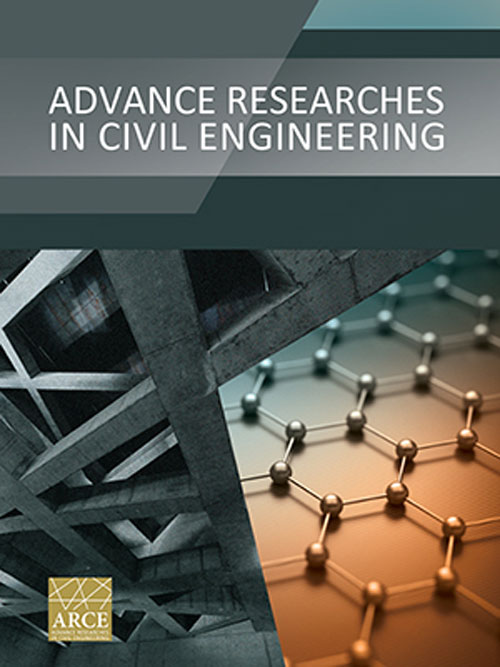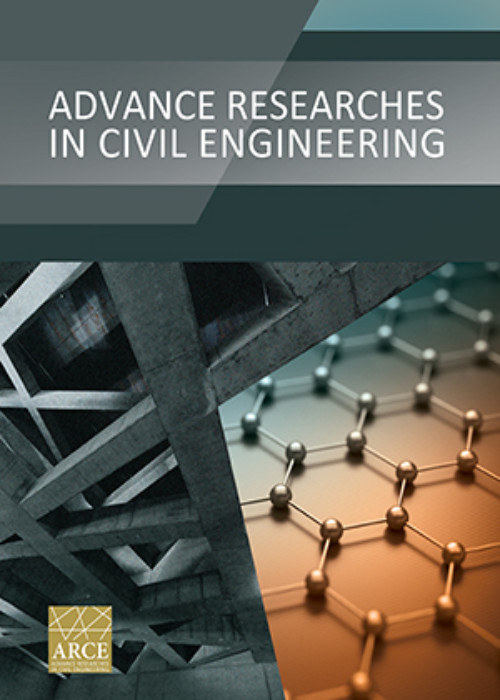فهرست مطالب

Advance Researches in Civil Engineering
Volume:3 Issue: 4, Autumn 2021
- تاریخ انتشار: 1401/01/16
- تعداد عناوین: 5
-
Pages 1-12Shear walls are widely used in steel and reinforced concrete buildings and have great importance among structural parts in medium and tall buildings as lateral loads are endured by shear walls. Coupled shear walls are being widely used in recent decades due to architectural and structural necessities. Most studies performed in this area, are addressing load transfer mechanisms, equilibrium equations of wall parts, fracture mechanisms, behavior of coupling beams and also system behavior against cyclic loads. However, effect of axial load in coupling beams has been neglected in these researches. Although many researchers considered this parameter as a negligible term in their works, a simple fact that if there is no axial load in coupling beams, there is no shear loads in the walls, proves inaccuracy of this assumption. The aim of this research is to use equilibrium equations and load transfer mechanisms for rearranging Total Moment Concept (TMC) equations and investigating coupled shear walls response against lateral loads. After improving TMC equations, a set of 3D finite element models are built to verify the results of this equations and compare the new equations to the original TMC equations. Afterwards, the required parameters for calculating TMC and Improved Total Moment Concept (ITMC) are extracted from these 3D models. It is shown that the improved equations are representing coupled shear walls behavior with more accuracy compared to the previous TMC equations. Finally, after comparing these two sets of results, some suggestions are given to improve the design process of coupled shear walls.Keywords: Coupled shear wall, Total Moment Concept, finite element analysis, Pushover analysis, Concrete damage plasticity
-
Pages 13-31In recent years, geopolymers, as a new class of green cement binders, have been considered as an environmental-friendly alternative to Ordinary Portland Cement (OPC) which can potentially reduce negative environmental impacts of OPC. Geopolymers are inorganic alumina-silicate materials produced from raw materials in combination with an alkaline activator solution. The alkaline activator solution as one of pillar of the geopolymerization process, playing an important role in the formation of crystalline structures of Si and Al. Therefore, it seems necessary to study the impact of various alkaline activator solutions on the mechanical strength of Geopolymer Concrete (GPC). On the other hand, in most pervious research, high temperature curing condition have been studied. Hence, in this research, granulated ground blast furnace slag and ambient curing condition were used to make GPC. The obtained results indicated that in ambient curing condition, using sodium hydroxide and sodium silicate, results in higher compressive strength as well as, lower permeability compared to potassium-based (potassium hydroxide and potassium silicate) and combination of sodium and potassium-based alkaline activator solutions. Moreover, simultaneous inclusion of NaOH and KOH led to decline the compressive strength. Furthermore, the obtained results indicated that increasing the NaOH and KOH concentration resulted in higher compressive strength. The optimal SiO2/Na2O ratio was 2 in the case of using 14M NaOH solution and 2.5 in the case of using 10M NaOH solution.Keywords: Geopolymer concrete, Granulated ground blast furnace slag, Compressive strength, Resistance to acidic condition
-
Pages 32-44Considering this point that Iran is located in the seismic belt, buildings must have enough strength against seismic loads. One of the methods against seismic load is the utilization of steel plate shear walls. Steel plate shear wall has been taken into account considerably in recent four decades in such a way that in many countries including the USA, and Japan using this system has become usual and common for strengthening of buildings against earthquake. Performed studies show a good performance of this system against lateral loads. Evaluation of seismic behavior of shear walls in various conditions can be a good guideline for optimum design of these walls. In this research, three different models of the shear wall have been built in finite element software of ABAQUS, and seismic properties of them including displacement and corresponding force or yielding limit, displacement and corresponding force or ultimate limit, absorbed energy and initial stiffness have been evaluated. Important results were obtained from performed research such as the existence of opening in steel plate shear wall in any state creates weak seismic performance in the wall, however, it can be profitable economically. Creating of opening in the middle plate of the shear wall in an amount of 17% can decrease the absorbed energy level of an earthquake by up to 15%. The seismic properties of shear walls containing rectangular and circular openings do not differ greatly from each other, therefore it is suggested that rectangular openings be used so that in addition to easier construction, the surrounding of the opening can be strengthened with FRP plates in case it was needed.Keywords: steel plate shear wall, opening, Seismic Load, finite element analysis, ABAQUS
-
Pages 45-55Considering the growth of industrialization for construction works, the role of on-site equipment and machinery in enhancing productivity and efficiency as well as improving working standards of construction. Hence, selecting the proper construction equipment is a challenging task owing to a wide range of available types as well as a host of criteria to be considered during decision making. However, the selection may result in incorrect decision-making or neglection of factors that are as important as cost or technical features. For this reason, nowadays the decision makers use multi-criteria decision making (MCDM) methods to make the most suitable or beneficial decision on machine and equipment selection. One of the most widely used construction equipment is wheel loader. This machine is widely used in all fields of construction. Therefore, proper selection based on the real needs of the project seems necessary. Hence, in this study, the selection of a suitable wheel loader was studied using MCDM methods. In this regard, an integrated approach using AHP and TOPSIS method for evaluating wheel loader selection were used. In this regard, the Analytic Hierarchy Process (AHP) and the Technique for Order Preference by Similarity to Ideal Solution (TOPSIS), are used in the evaluation procedure. More precisely, AHP is applied to determine the relative weights of evaluation criteria and TOPSIS is applied to rank the wheel loader alternatives. The proposed approach also provides a relatively simple and very well suited decision making tool for this type of decision making problems.Keywords: Wheel loader selection, AHP, TOPSIS, MCDM, Construction equipment selection
-
Pages 56-65Almost all construction projects are almost certain to experience delays that occur at each stage of the project including the planning and design stages. In the implementation of infrastructure projects such as wastewater piping networks, there are still frequent delays in the planning and design stages. This is of course influenced by many factors, including the low use of Advanced Engineering Software. The use of conventional software such as Microsoft Excel is still an option in sewerage analyzing so that it takes more time to design or correct the design. Therefore, this study was conducted to determine the factors in the use of hydraulic engineering software that affect the design time performance of the sewerage. The results of multiple linear analysis show that with the simultaneous use of the factors of ease of analysis, clear visualization, design coverage, scenario management, automated design, integration with GIS, conversion and accuracy have a positive influence on the design time of the sewerage where the most influential factor is scenario management.Keywords: Sewerage Project, Engineering Software, Design phase, Time Performance


